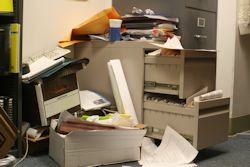Slips, Trips, and Falls
Slips, trips, and falls constitute the majority of general industry accidents. They cause 15% of all accidental deaths, and are second only to motor vehicles as a cause of death. OSHA addresses hazards associated with slips, trips, and falls in its rules for walking/working surfaces and fall protection.
- Walking/working surfaces means any surface, whether horizontal or vertical on which an employee walks or works, including, but not limited to, floors, roofs, ramps, bridges, runways, formwork, and concrete reinforcing steel but not including ladders, vehicles, or trailers, on which employees must be located in order to perform their job duties.
- Fall protection means equipment in four categories, such as fall arrest and positioning systems, guardrail systems, suspension, retrieval, and safety monitoring systems, to prevent falls from elevated surfaces.
The Most Common Accident
According to the National Safety Council, workers are injured from slips, trips, and fall accidents more than any other occupational injury. These can often be avoided if proper housekeeping procedures are used. It is not uncommon for a worker to trip on a piece of equipment or tool that they themselves forgot to put away.

The solution is reflected in the old adage of "having a place for everything and putting everything in its place." Like "safety" itself, good housekeeping is everyone's responsibility. Let's discuss this important topic in the next section.
Knowledge Check Choose the best answer for the question.
3-1. According to the National Safety Council, which of the following accident types results in most occupational injuries?
You forgot to answer the question!
